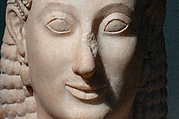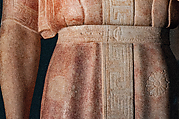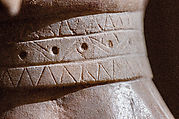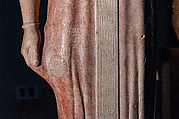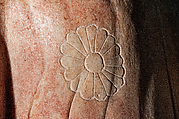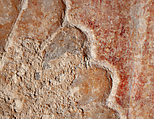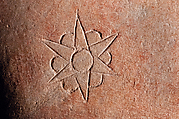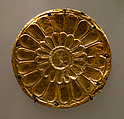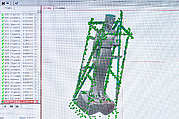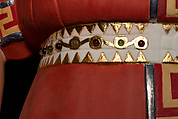Returned to lender The Met accepts temporary loans of art both for short-term exhibitions and for long-term display in its galleries.
Reconstruction of the marble funerary stele of Phrasikleia
Vinzenz Brinkmann German
Ulrike Koch-Brinkmann
Not on view
"This richly decorated statue stood on the tomb of a girl named Phrasikleia. She wears a crown of lotus buds and holds a single bud in her left hand. The epigram on the base tells us that she died young, before she could marry.
The famous sculptor Aristion of Paros signed the work. With the help of ultraviolet-visible absorption spectroscopy (UV-Vis spectroscopy) and X-ray fluorescence spectroscopy (XRF), traces of a numbers of colors on the flesh and clothing could be identified: red and brown madder, red and brown ocher, lead white for the eyes, flesh, and hair, as well as three different reds and yellows (red and yellow iron oxide and orpiment for the garment). Wherever the underside of the fabric is visible - on the sleeve and the lower hem - a dark red pigment (hematite) was deliberately used. Gold leaf and lead tin foil that gleams like silver were applied to the dress and the jewelry.
Metal rosettes and shiny yellow swastikas (painted with orpiment and gold ocher) were scattered over the entire garment. Additionally, stars appear on the back of the garment, evidently intended to represent a constellation.
The reconstruction made in 2010 follows the incised patterns and colors that were identified by scientific analysis. But after the latest discoveries by the conservators in the Athens National Museum, the red ocher of the robe has been mixed with cinnabar, giving the color an even more intense effect. The polish of the skin was based on contemporary Egyptian mummy portraits and was
done using agate, while a shimmering lacquer (gum arabic) was applied to the irises of the eyes. In 2019, gilding was added to the volute ornament of the belt and precious stones were inserted into the round depressions that are still preserved."
Vinzenz Brinkmann and Ulrike Koch-Brinkmann
2010/2019
Reconstruction 2010/2019
marble stucco on PMMA, natural pigments (chromatographically calibrated) in egg tempera, lead tinfoil, gold leaf, garnet, tourmaline, labradorite, gum arabic (for the irises)
H. 200 cm.
3-D scan and printing in PMMA: Ursula Buck, Thorsten Schwing, GOM Braunschweig, Alphaform Munich; restorations: Christian Tobin; gilding: Corinna Bohn; gemstones: Kristina Balzer
Liebieghaus Skulpturensammlung, Frankfurt am Main (on loan from the Ludwig-Maximilians-Universität, Munich, Leibniz Prize O. Primavesi 2007), inv. LGLH Z 01
Scientific methods employed:
Ultraviolet-induced visible luminescence imaging (UVL) (Schott KV 418)
Ultraviolet-reflected imaging (UVR) (Schott UG1 or Schott BG12)
Optical stereoscopic microscopy (10–50x, Zeiss and Olympus)
Raking light imaging (Schott KL1500)
Black-and-white imaging in visible light (VIS)
Color imaging in visible light (VIS)
Photomicrograph (with microscope or macro objectives)
3-D scan (GOM Atos)
Ultraviolet-visible absorption spectroscopy (UV-Vis spectroscopy)
X-ray fluorescence spectroscopy (XRF)
Scientific evaluation
Vinzenz Brinkmann, Ulrike Koch-Brinkmann, Heinrich Piening
Pigments used in the reconstruction
red: burnt Cypriot yellow ocher, cinnabar, red ocher, hematite; yellow: light yellow Cypriot ocher, gold ocher, orpiment; white: lead white; brown: brown madder, umbra; black: vine black; flesh color: red and yellow ocher, lead white (polished)
Acknowledgements
GOM Braunschweig
Ursula Buck, Thorsten Schwing
Leibniz-prize 2007 Oliver Primavesi (Deutsche Forschungsgemeinschaft)
Nikolaos Kaltsas, Athens
National Archaeological Museum, Athens
This image cannot be enlarged, viewed at full screen, or downloaded.
This artwork is meant to be viewed from right to left. Scroll left to view more.



